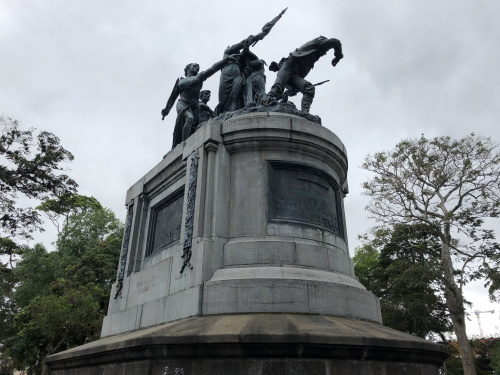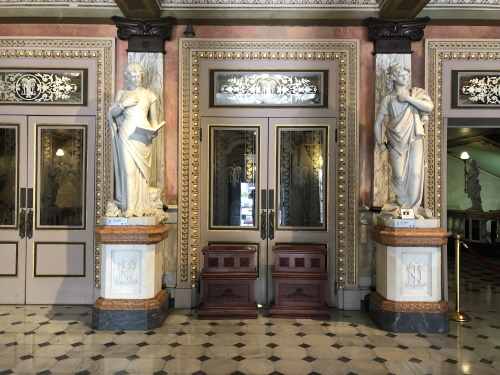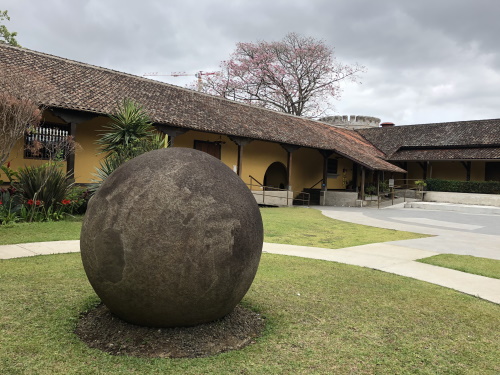Blog TWHS Visits
San José
At every new country that I visit, I always try to stay at least one full day in its capital. I definitely won’t say that with visiting a capital you can ‘tick’ a whole country (I am looking at you, 193 chasers, who claim Botswana and Namibia after having set foot only in Gaborone and Windhoek!) – but I also believe that you miss out on something when you don’t visit a country’s capital. Even when that capital city in itself is not ranked that high by others, I do enjoy observing how the country sees itself / presents itself. Any National Museum is a great place to do so, as well as a city park, a seat of parliament or a major religious building.
Costa Rica’s capital San José is a typical one that gets skipped easily – “it’s not a bad place to get things done that can’t be done elsewhere” is among the more positive praise. Fortunately I was in the hands of fellow WH Traveller, Costa Rican native ánd architect Esteban. He guided me around for a full day. We started in the morning by walking from one architectural highlight to another in the mostly low-rise residential and business areas just outside the city center.
The thing with San José is that it has never been that rich in the past, it suffered from serious earthquakes and a lot of demolitions for the sake of modernity. The latter is still going on til today, creating parking lots is the new craze. The buildings we stopped at included schools, private residences, former factories and the railway station. Styles range from the neoclassical to the “Hollywood colonial style”, the eclectic and brutalist. We literally saw dozens of them, but they would be hard to find for an outsider as they are so scattered around.
San José has no WHS but it had two TWHS in the past: the National Monument and the National Theatre. Both disappeared from the T List quietly after having been rejected in 1980 without any reason given.
The National Monument is a dramatic bronze statue that commemorates Costa Rica’s victory in the War of 1856-57 – a war against the invaiding forces of ‘filibuster’ William Walker who wanted to create English-speaking, slave-holding colonies in Central America under his own control. This war, that cost the lives of 10,000 Costa Ricans, also gave the country its nation hero (Juan Santamaría, who sacrificed himself – San José airport is named after him). The statue shows all parties involved (women representing each Central American nation and the fleeing William Walker). It’s a part of history of which few people will have heard globally, but it defines independent Central America. The monument lies at the center of a pleasant little city park.
The National Theatre opened in 1897, during an economic boom caused by coffee exports. It was funded by levying a tax on coffee. It is considered the finest historic building in San José and is known for its lavishly furnished interior. Unfortunately we didn’t get beyond the lobby, as the building can only be visited on a guided tour for which we were too early. Still it was the most opulent building that we saw on our day around San José.
San José has three major historical museums – the National Museum, the Gold Museum and the Jade Museum. We visited the first two, and I’d like to focus on the National Museum as this is where the idea of Costa Rica presenting itself can be felt the strongest.
The National Museum is almost symbolically housed in former army barracks, which ceased to be necessary when the Costa Rican army was abolished in 1948. Two of its towers (one with a lot of bullet holes) still stand as do the dungeons where prisoners were kept. The first hall of the museum is a butterfly garden, certainly the first one that I have seen in a National Museum around the world! After that you enter the open air central plaza of the barracks, it is here where a number of stone spheres have been brought from the Diquis area. The more conventional exhibition rooms tell the story of the country from the indigenous chiefdoms via the coffee and banana booms to the welfare state of the 20th century.
Els - 21 March 2021
Comments
Esteban Cervantes Jiménez 29 March 2021
It was a great pleasure to guide you through the city, Els! In the end, I made the count and we saw like 59 of the 90 heritage-declaredbuildings in the municipality of San José (and many more who would be worthy of an addition to that list). I just regret we couldn't fit the chance to see the buildings from the Carmen church to the Post office, and the area around the Merced church-former Fire station-San Juan de Dios hospital-former Chapuí asylum. But it was great. I think the best experience for someone visiting would be to give 1 day for a tour of the city and another one for the cited museums (plus maybe the National Art Museum and a tour of the Theater).
Els Slots 22 March 2021
Thanks Jay T. I will review some of the FTWHS as well, as they are still among the most interesting cultural sites of the country.
Jay T 22 March 2021
Sounds like you got to see a lot in San Jose thanks to Esteban! I look forward to the reviews on Costa Rican sites; it’s a country I really should visit some day since it is so close.
Michael Ayers 21 March 2021
Esteban sounds like Una Guia Bien!


